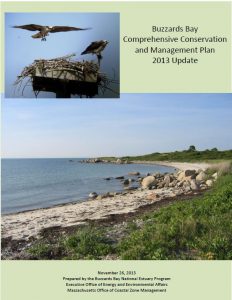2013 CCMP, Action Plan 16:
Reducing Toxic Pollution
About the new Buzzards Bay CCMP Action Plans
The Buzzards Bay Comprehensive Conservation and Management Plan (CCMP) was updated in November 2013 to reflect the great progress achieved since the original CCMP was finalized. You can download the entire document (buzzards-bay-ccmp-2013-update.pdf) or just this action plan Reducing Toxic Inputs to Buzzards Bay.
Reducing Toxic Pollution
Problem
Toxics enter Buzzards Bay from many sources and via numerous pathways. The largest single toxic pollution management problem remains the cleanup of the U.S. EPA Superfund site in New Bedford Harbor, which at the current rate of cleanup may take another 40 years to complete. There are 4 additional Superfund sites in the Buzzards Bay watershed, and 102 hazardous waste sites altogether on the state’s Chapter 21E list. All these sites may be cleaned up in a timelier manner.
Beside these known hazardous waste sites, there are many past and ongoing inputs and pathways of toxic contamination to Buzzards Bay and its watershed. A number of embayments are identified in the states 303(d) Integrated List, and will require the development of TMDLs to manage chronic inputs. Some of the environmental impacts of these contaminants are not fully understood, and will require further study. The cleanup of the existing hazardous waste sites and controlling the numerous nonpoint inputs to the environment remains one of the most complicated challenges that must be addressed in the Buzzards Bay CCMP.
This action plan focuses on reducing and eliminating toxic inputs into the bay in order to improve bay conditions and minimize the costs of cleanup and mitigation. Both point and nonpoint sources are addressed.
Several other action plans provide recommendations that are directly related to this issue, including those for reducing oil pollution, managing dredging and dredged material disposal, managing wastewater industrial discharges, and managing stormwater runoff.
Goal
Goal 16.1. Protect public health and the bay ecosystem from the effects of toxic contamination.
Objectives
Objective 16.1. To reduce the amount of toxic contamination entering Buzzards Bay and water bodies listed under the 303(d) program.
Objective 16.2. To eliminate hazardous discharges of toxic contaminants from point sources into the bay.
Objective 16.3. To reduce the discharge of toxic contaminants and contaminants of emerging concern into wastewater systems (both septic and sewer).
Objective 16.4. To reduce hazardous discharges from nonpoint sources of toxic contaminants into the bay.
Objective 16.5. To meet all state, federal, and local action levels for water and seafood.
Objective 16.6. To improve local, state, and federal regulation and control of seafood and sediment quality to protect human health and the environment.
Approaches
Implementing this action plan is complex because it involves industry, residential activity, the choice of products and compounds used, and regulated and non-regulated business activities. However, across all these activities and sectors of the economy, pollution prevention is one of the most important actions for achieving the goals of the action plan.
The second most important element is to ensure proper disposal and recycling of toxic materials. For example, fishing vessel owners often discharge oily bilge water because existing collection services are too expensive. In this regards, DEP should fund the construction of a facility to collect bilge oil along New Bedford Harbor that accepts oily bilge water for recycling and treats it at an affordable rate to boaters and the fishing fleet. Expansion of hazardous waste collection days, increased conventional recycling programs, and year round availability of facilities to dispose of waste oil, tires, leads and cadmium batteries and fluorescent tubes will offer proper disposal opportunities. The failure to have a speedy cleanup of hazardous waste sites, especially federal superfund sites, remains an important need, as these cleanups have been unacceptably slow.
Costs and Financing
The costs to implement this action plan are as varied as the sectors and pollution sources that must be managed, and the New Bedford Superfund cleanup dwarfs all others. One non-Superfund need is funding for the design, permitting, and construction, of an oily bilge water-collection and treatment facility in New Bedford, which will likely cost $500,000 to build, and tens of thousands of dollars per year to operate. The construction and operation of this facility could be funded by the Massachusetts Oil Spill Act fund.
There are many other costs associated with this action plan. Hazardous material disposal collections are expensive, and municipalities can often only afford one collection event annually, if at all. There are costs to ex-pand conventional recycling programs as well.
Measuring Success
The success of this action plan can be evaluated by the amount of hazardous materials collected, the concentration of toxic contaminants in wastewater facility dis-charges, and by various programmatic and management action, measures.
